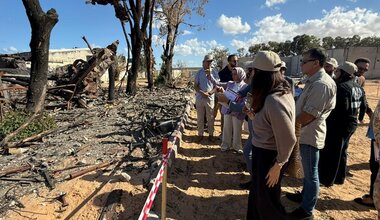Civilian Casualties Report 1 January- 31 March 2020
The UN Support Mission in Libya (UNSMIL) releases its first quarter civilian casualty report for 2020. The data shows an increase in civilian casualties from the armed conflict in Libya. UNSMIL renews its call for all parties to the conflict to immediately halt all military operations and respect international human rights and humanitarian law, to protect civilians and allow the authorities to respond to the threat of COVID-19.
Between 1 January and 31 March 2020, UNSMIL documented at least 131 civilian casualties (64 deaths and 67 injuries). This figure represents an overall increase in civilian casualties of 45 per cent compared to the preceding period in the fourth quarter of 2019[1] with a 113 per cent increase in deaths and an 11 per cent increase in injuries. The victims include 82 men (43 deaths and 39 injuries), 22 women (nine deaths and 13 injuries), 19 boys (seven deaths and 12 injuries), and eight girls (five deaths and three injuries). Ground fighting was the leading cause of civilian casualties, followed by targeted killings, airstrikes, and improvised explosive devices.
The overall increase in civilian casualties was driven by escalation of hostilities, despite the calls for an immediate cessation of hostilities by the United Nations[2] and many UN Member States. UNSMIL is very concerned by the continued indiscriminate attacks and targeting of civilians in civilian populated areas and the increase in civilian casualties from the use of rockets and artillery, as well as from targeted killings by forces affiliated to the “Libyan National Army” (LNA).

“In the morning on Monday, I was at my home. Suddenly, a rocket hit my neighbor’s house. After a while, other local people and I went to my neighbor, where we saw dead bodies of a woman and a man, both were hit by the rocket on upper parts of the body. The explosion also damaged the house. I urge all parties to the conflict not to harm innocent civilians”.
- Witness of a rocket attack that killed two civilians on 23 March 2020 in the Ain Zara neighborhood of Tripoli.

During the first three months of 2020, ground fighting was the leading cause of civilian casualties, causing 73 per cent of the total. UNSMIL documented 78 civilian casualties (32 deaths and 46 injuries) from the use of heavy weapons (rockets/artillery/mortars), and 18 civilian casualties (12 deaths and six injuries) from the use of small arms fire.
Targeted killings were the second leading recorded cause of civilian casualties with 20 victims (14 deaths and six injuries), representing 15 per cent of the total civilian casualties. Airstrikes were the third leading cause of civilian casualties with nine victims (six deaths and three injuries), followed by improvised explosive device (IEDs) with six injuries.
Like the fourth quarter of 2019, civilians living in the western part of Libya were most affected. Since the outbreak of conflict on 4 April 2019, fighting between forces affiliated to the LNA and the GNA continued to gain control of areas in the western Libya. UNSMIL documented 117 civilian casualties (53 deaths and 64 injuries) in western Libya, amounting to 89 per cent of the total. The remaining 11 per cent of the total civilian casualties (11 deaths and three injuries) occurred in the central part of the country.

During the first quarter of 2020, forces affiliated to the “Libyan National Army” (LNA) caused 106 civilian casualties (49 deaths and 57 injuries), 81 per cent of the total. Of these, UNSMIL documented 83 civilian casualties (34 deaths and 49 injuries) from ground fighting, followed by nine civilian casualties (six deaths and three injuries) from air strikes and 14 civilian casualties (nine deaths and five injuries) from targeted killings.
Forces affiliated to the Government of National Accord (GNA) killed six civilians during the ground fighting, representing five per cent of the total. The remaining seven civilian casualties (four deaths and three injuries) resulted from ground fighting between forces affiliated to the LNA and GNA, six civilian casualties (five death and one injury) from targeted killings, and six injuries from IEDs could not be attributed to a specific party to the conflict.
Impact of conflict on Healthcare and Education
UNSMIL continued documenting attacks on schools and healthcare facilities that impede access to education and health services by civilians in Libya. Between 1 January and 31 March 2020, UNSMIL documented nine incidents that impacted education, one of which was attributed to forces affiliated to the LNA and eight others could not be attributed to one specific party to the conflict, as they occured during cross-fire between forces affiliated to the LNA and GNA. One improvised explosive device detonated in al-Zawiyah, western Libya, injuring three schoolboys. While no casualties were recorded from the indiscriminate shelling (rocket/artillery) that impacted eight schools in western Libya, the attacks spread fear among the students and their families and led to the closure of some schools.
In addition to attacks on schools, UNSMIL documented two incidents targeting healthcare personnel during the first three months of 2020.[3] One incident was the arbitrary arrest of a medical official by the LNA in Derna in eastern Libya, while the other incident was the abduction and killing of a doctor in the Ain Zara neighborhood of Tripoli. Although the perpetrator of the second incident remains unknown, the reported location of the incident is under control of forces affiliated to the GNA.
Note: The work of UNSMIL on civilian casualty recording is based on principles of international humanitarian law and international human rights law, and the guidance of the Office of the United Nations High Commissioner for Human Rights (OHCHR). During the verification process, UNSMIL staff contact a wide range of sources of information and analyze them for reliability and credibility before conclusions are drawn. Every effort is made to ensure that data contained in this UNSMIL report is as comprehensive as possible; however, the data presented is not exhaustive. Where UNSMIL is not satisfied with the evidence concerning an incident, it will not be reported. In some instances, investigations may take several weeks before conclusions can be made. This also means that conclusions concerning such incidents or alleged violations may be adjusted as more information becomes available and is analyzed. However, if information is equivocal, then conclusions will not be drawn until more satisfactory evidence is obtained, or the case will be closed without conclusion and it will not be included in statistical reporting. As information is updated, and conclusions and statistics are modified, this can result in slight differences in reporting of the same incident or variations in statistics reported by UNSMIL over time.
The ability of UNSMIL to record and verify civilian casualties is persistently hampered by access restrictions and security concerns as well as the continued armed conflict in Libya.
Contact UNSMIL (unsmil-monitoringhumanrightsteam@un.org) if further information is required or to report a conflict-related incident that caused harm to civilians in Libya.
[1] UNSMIL documented 90 civilian casualties (30 deaths and 60 injured) in the fourth quarter of 2019.
[2] Recently, the United Nations Humanitarian Coordinator for Libya and the Acting SRSG for Libya called for a humanitarian pause on 22 and 24 March 2020 respectively.
[3] In total WHO reported seven attacks on health care resources, five of which it had confirmed for the period 1 January-31 March 2020: three attacks impacting healthcare facilities, two attacks impacting healthcare transport, with four of the said attacks impacting healthcare personnel, see https://publicspace.who.int/sites/ssa/SitePages/PublicDashboard.aspx
 United Nations Peacekeeping
United Nations Peacekeeping UN
UN









